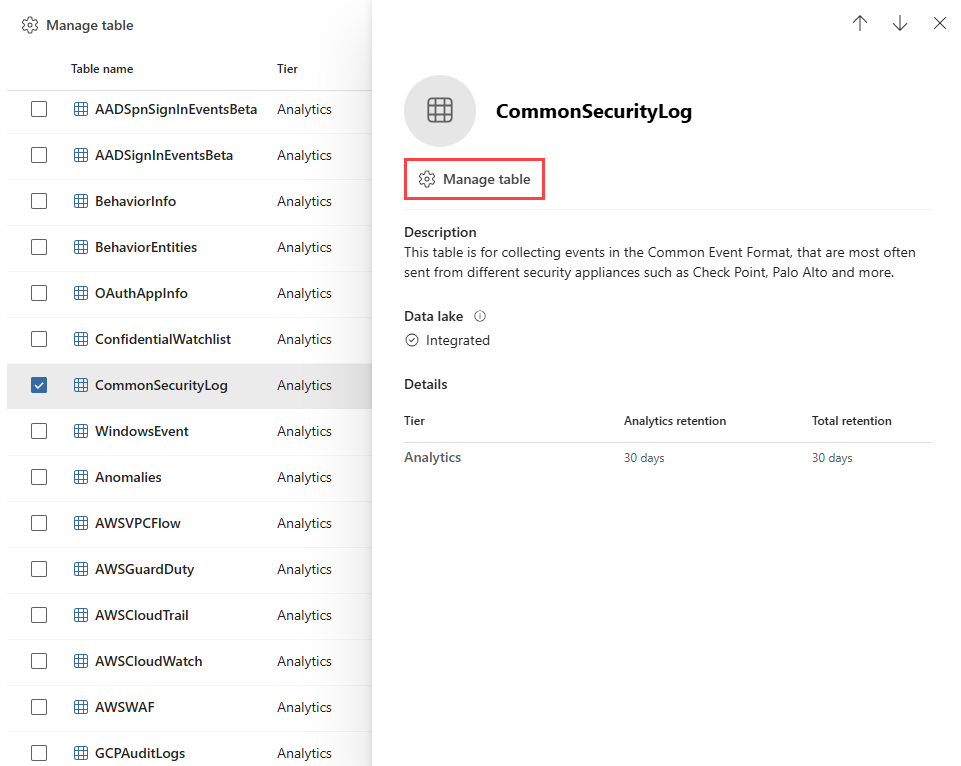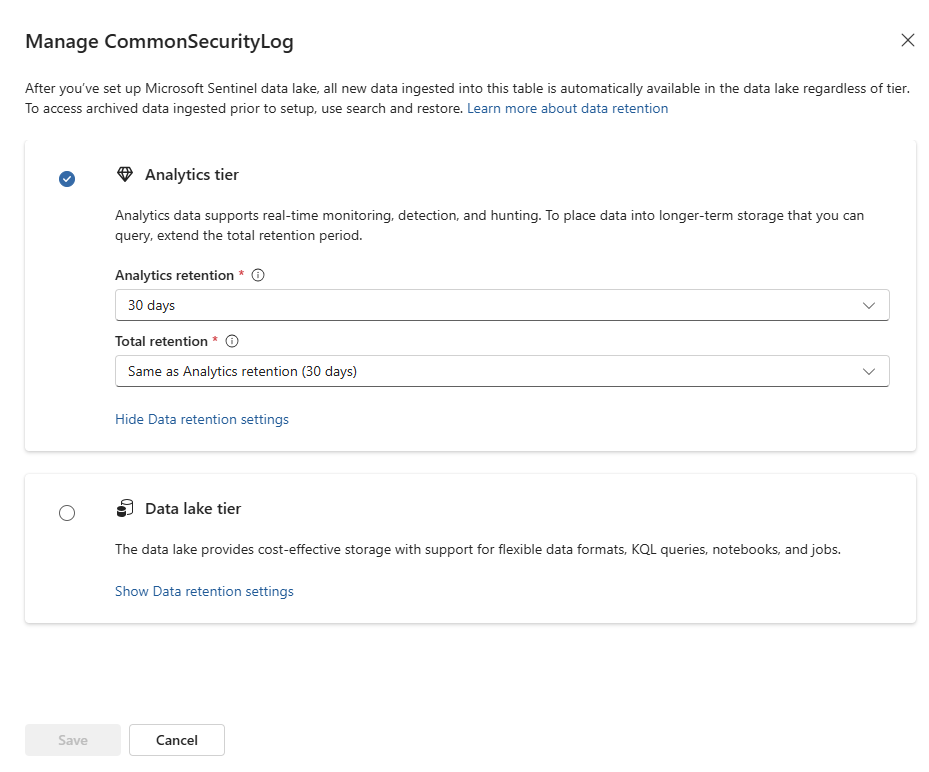Note
Access to this page requires authorization. You can try signing in or changing directories.
Access to this page requires authorization. You can try changing directories.
The Microsoft Defender portal provides a centralized experience for configuring table-level data retention and tier settings across Microsoft Sentinel and Microsoft Defender XDR. You can view and manage retention settings, switch between analytics and data lake tiers, and optimize data storage based on operational and cost requirements.
This article explains how to configure retention and tier settings for tables in Microsoft Sentinel and Defender XDR in the Microsoft Defender portal.
For more information about how data tiers and retention work, see Manage data tiers and retention in Microsoft Sentinel (preview).
Prerequisites
- To manage Defender XDR hunting tables, you need to onboard to Microsoft Sentinel in the Defender portal. For more information, see Connect Microsoft Sentinel to the Microsoft Defender portal.
Permissions required
Microsoft Sentinel workspace permissions let you view or manage tables in specific Microsoft Sentinel workspaces, while unified RBAC permissions apply to all Microsoft Sentinel workspaces in the Defender portal.
| Action | Unified role-based access control (RBAC) in the Defender portal | Microsoft Sentinel workspace permissions |
|---|---|---|
| View table settings | Security data basics (read) permissions under the Security operations permissions group |
Microsoft.OperationalInsights/workspaces/tables/read permissions to the Log Analytics workspace, as provided by the Log Analytics Reader built-in role, for example. |
| Configure table settings | Data (manage) permissions under the Data operations permissions group |
Microsoft.OperationalInsights/workspaces/write and Microsoft.OperationalInsights/workspaces/tables/write permissions to the Log Analytics workspace, as provided by the Log Analytics Contributor built-in role, for example. |
For more information about unified RBAC in the Defender portal, see Microsoft Defender XDR Unified role-based access control (RBAC).
For more information about Microsoft Sentinel workspace permissions, see Roles and permissions in the Microsoft Sentinel platform.
Manage table settings
To view and manage table settings in the Microsoft Defender portal:
Select Microsoft Sentinel > Configuration > Tables from the left navigation pane.
The Table screen lists all the tables you can manage in the Microsoft Defender portal and the settings of each table.
The workspace column shows the Microsoft Sentinel workspace in which a Microsoft Sentinel or custom table is stored.
To manage Microsoft Sentinel and custom tables in a different Microsoft Sentinel workspace, select the workspace name at the top left corner of the screen to switch between workspaces.
Select a table on the Tables screen.
This opens the table details side panel with more information about the table, including the table description, tier, and retention details.
Select Manage table.
The Manage table screen lets you modify the table's retention settings in the current tier, and change the storage tier, if necessary.
Analytics tier retention settings:
Analytics retention: 30 days to two years.
Total retention: Up to 12 years of long-term storage in the data lake. By default, total retention is equal to analytics retention, which means long-term retention isn't applied. To enable long-term retention, set the total retention to a value greater than analytics retention.
Example: To retain six months of data in long-term retention total and 90 days of data in analytics retention, set Analytics retention to 90 days and Total retention to 180 days.
Data lake tier retention settings: Set Retention to a value between 30 days and 12 years.
Tier changes: If necessary, you can change tiers at any time based on your cost management and data usage needs.
Note
Tier changes aren't available for all tables. For example, XDR and Microsoft Sentinel solution tables must be available in the analytics tier because Microsoft security services require the data in these tables for near-real-time analytics.
For more information about retention and tier settings work, see Manage data tiers and retention in Microsoft Sentinel (preview).
Review warnings and messages. These messages help you understand important implications of changing table settings.
For example:
- Increased retention is likely to lead to increased data cost.
- Changing from the analytics to the data lake tier causes features that rely on analytics data to stop functioning such as:
- Alerting
- Advanced hunting
- Analytics rules
- Custom detection rules
Select Save to apply the new settings.
Next steps
Learn more about:


